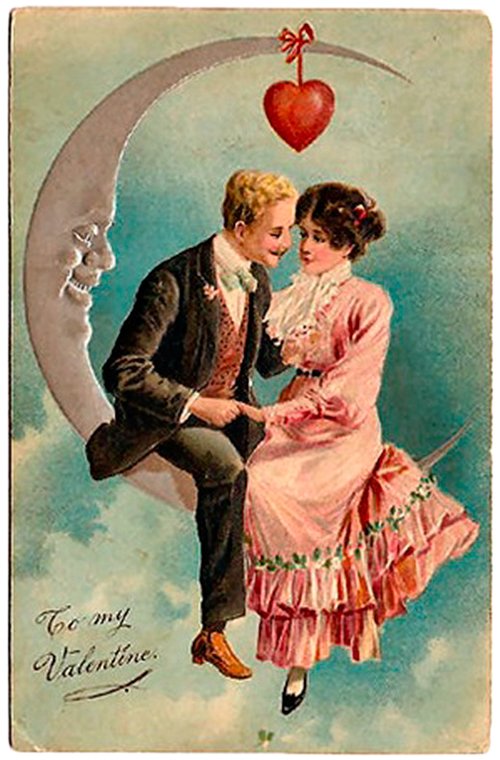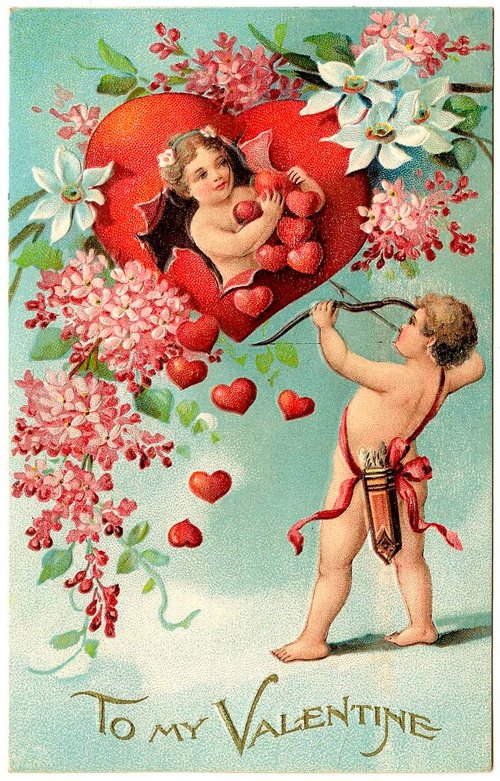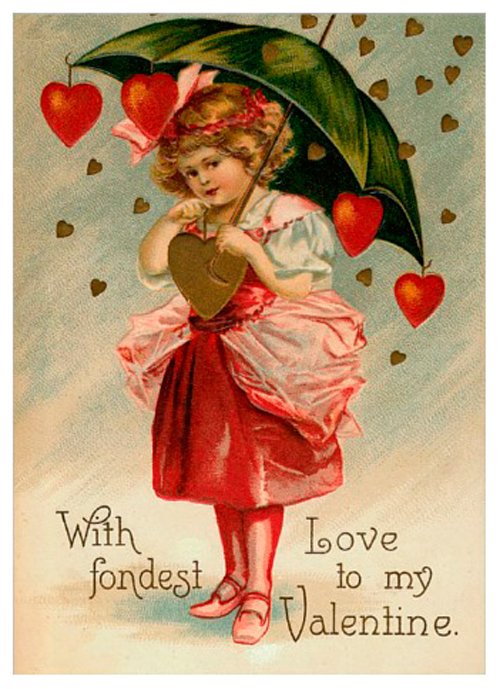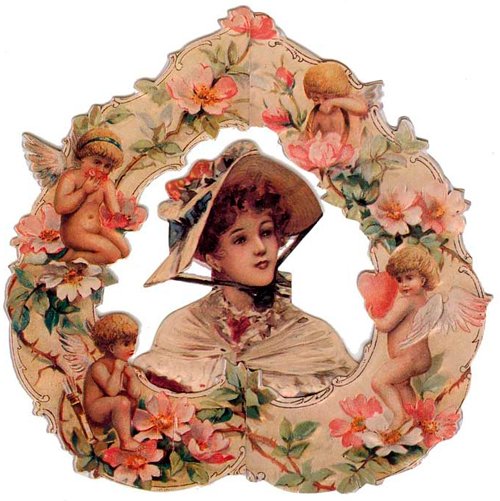Victorian Valentines
Ahead of this Valentine’s Day, I was thinking of the old Australian film that is set on this day in 1901: Peter Weir’s Picnic at Hanging Rock, which is based of course on Joan Lindsay’s book of the same name. In one of the early scenes, the schoolgirls exchange cards, and Miranda of course receives the most.
I was inspired to look some up. I just love the graphics of this era: they are cute, kitsch and colourful. Scrapbooking was hugely in fashion in the nineteenth century, especially for women and children (read about them here), and there were myriad types of diecut illustrated graphics used for this purpose. The greeting cards in this style I love the most – they look so tactile too. The last two are termed ‘Vinegar Valentines’, and they are very amusing as well, although you’d be mortified to receive one!
Scroll down and smile. (I have included links were they were available.)
Rage!
 Rage! Digital drawing on vintage paper, Helena Turinski, 2015 I was looking for something today in my archives and came across this amusing digital sketch that I had forgotten about. I created it about a year and a half ago as an experiment, using a page from a 1931 journal I had bought from an antiquarian shop.
Rage! Digital drawing on vintage paper, Helena Turinski, 2015 I was looking for something today in my archives and came across this amusing digital sketch that I had forgotten about. I created it about a year and a half ago as an experiment, using a page from a 1931 journal I had bought from an antiquarian shop.
The concept was related to a random poem I was working on at the time, but it didn’t work as part of a collage and I set it aside. Now, the visceral emotion quite amuses me. I certainly wasn’t angry, but rather gleefully exuberant!
The biggest compliment I received when a friend of mine, another artist, saw some of my digital ink drawings and assumed they were created traditionally. I think doing them this way frees me up much more than if I was using real ink – I know I’d be anxiously worrying about wrecking irreplaceable and unique vintage papers. The other concern is that this paper is very thin and delicate, and would not be able to handle much medium at all. In the end, if I can create a realistic effect digitally, I am happy.
The Essence of Summer
 Fabs, 2011Ah, summer! A season of childhood memories of playing under the sprinkler on hot summer days, running around barefoot all day and night, listening to the crickets singing as though their hearts (and our ear drums) would burst, eating Sunnyboys – frozen fruit-flavoured treats – on especially sizzling days, but one of my favourite memories is of eating home-grown sweet corn grilled until it blistered, in the back yard under the stars.
Fabs, 2011Ah, summer! A season of childhood memories of playing under the sprinkler on hot summer days, running around barefoot all day and night, listening to the crickets singing as though their hearts (and our ear drums) would burst, eating Sunnyboys – frozen fruit-flavoured treats – on especially sizzling days, but one of my favourite memories is of eating home-grown sweet corn grilled until it blistered, in the back yard under the stars.
These icy treats on my February calendar page epitomise summer, and are painted by artist Joël Penkman in egg tempera on board. He specialises in paintings of food:
‘I love food, and I love to paint, so combining the two seemed like a good idea. It's easy to find a cooperative subject and I like its familiarity, it is something everyone can relate to. It can hold memories, tell stories, explore national and local identity, and make us hungry. Often it will be something sweet as these foods are made to look appealing, filled with artificial colours and pressed into interesting shapes. It is a fun, playful subject.’
Happy February!
~
You can read an interview with Penkman and view galleries of his work on his website joepenkman.com.
Madeline Goes Down Memory Lane
 To the tiger in the zoo, Madeline just said, "Pooh-pooh…", from Madeline, 1939Amongst the many classic children’s books that I have fond memories for, one series recently came back to mind: those of Madeline, by Ludwig Bemelmans (1898–1962).
To the tiger in the zoo, Madeline just said, "Pooh-pooh…", from Madeline, 1939Amongst the many classic children’s books that I have fond memories for, one series recently came back to mind: those of Madeline, by Ludwig Bemelmans (1898–1962).
Bemelmans was born in Austria-Hungary but emigrated to America as a youth after an unfortunate incident in which he shot and seriously wounded a waiter at his uncle’s hotel! He became a US citizen in 1918, living mostly in New York. It was there in the 1930s that he began writing and publishing children’s books, and the first Madeline book – a manuscript scrawled on the back of a bar menu – appeared in 1939. He published only six stories of her, though a seventh was discovered after his death. He also wrote many books for adults, and illustrated for magazines such as The New Yorker, Harper’s Bazaar and Town & Country.
 The girls in midwinter; watercolor and gouache, from Madeline, 1939I don’t actually remember the stories themselves very well, but the beautiful illustrations have always stuck with me. Bemelmans worked in watercolour, gouache, and oils, and there is a marvellous freedom of expression and lack of self-consciousness – as well as joyful humour – in the linework. It is that wonderful joie de vivre in the lighthearted drawings, as well as the feisty personality of the heroine, that is so appealing and memorable. My favourites out of this series is the drawing of the tiger, which looks absolutely and hilariously insane, and the delightful oil painting of Madeline at the flower market.
The girls in midwinter; watercolor and gouache, from Madeline, 1939I don’t actually remember the stories themselves very well, but the beautiful illustrations have always stuck with me. Bemelmans worked in watercolour, gouache, and oils, and there is a marvellous freedom of expression and lack of self-consciousness – as well as joyful humour – in the linework. It is that wonderful joie de vivre in the lighthearted drawings, as well as the feisty personality of the heroine, that is so appealing and memorable. My favourites out of this series is the drawing of the tiger, which looks absolutely and hilariously insane, and the delightful oil painting of Madeline at the flower market.
Scroll down for a trip down memory lane to childhood.
 Madeline's Rescue, 1953
Madeline's Rescue, 1953 Madeline at the Paris flower market, painting in oils from 1955
Madeline at the Paris flower market, painting in oils from 1955 Pen, ink, watercolor, and gouache of a dummy cover for the title Madeline and the Bad Hat, 1956
Pen, ink, watercolor, and gouache of a dummy cover for the title Madeline and the Bad Hat, 1956 Madeline and the Bad Hat, 1956
Madeline and the Bad Hat, 1956 Madeline and the Bad Hat, 1956
Madeline and the Bad Hat, 1956 Madeline and the Gypsies, 1959Images from Daily Mail.
Madeline and the Gypsies, 1959Images from Daily Mail.
Postcards from Portugal
 Recently, I was rearranging my home-office, which forced me to do some sorting and tidying and chucking-out. During this tedious process I came across a bag (shoved under my desk) of ephemera collected on my overseas trip to Spain, Portugal and Morocco years ago.
Recently, I was rearranging my home-office, which forced me to do some sorting and tidying and chucking-out. During this tedious process I came across a bag (shoved under my desk) of ephemera collected on my overseas trip to Spain, Portugal and Morocco years ago.
I kept the travel journal (naturally) and a few other design-related items like these reproductions of quaint vintage postcards, and threw out the remainder.
Unfortunately the reverse sides of the postcards are singularly uninformative, with only the words ‘Publicidade e ilustração, Portugal século XX’, along with an obscure edition number and web address that goes to a blog about unique engagement rings.
Fado is a traditional style of Portuguese music, which can be traced back to the 1820s, and is characterised by mournful tunes and music. I guess in this case these songs are about cigars?
 I never sampled Ginja de Portugal while on holiday in Portugal, but it is a liqueur made from sour cherries with sugar and alcohol. Possibly it is similar to the Croatian Maraska cherry wine, which is neither a wine nor a liqueur, but is a perfect accompaniment to desserts.
I never sampled Ginja de Portugal while on holiday in Portugal, but it is a liqueur made from sour cherries with sugar and alcohol. Possibly it is similar to the Croatian Maraska cherry wine, which is neither a wine nor a liqueur, but is a perfect accompaniment to desserts.
The other two cards show a naïve folk style of illustration lauding the joyful, sun-filled lifestyle to be found in Portugal.
I found these postcards in an intriguing store in Lisbon, which was part-giftshop, part-design-emporium. I also purchased a book on vintage packaging, and a few pieces of vintage ephemera – random collections of actual items packaged in cellophane envelopes. It was a lovely little shop to spend an hour browsing in.












